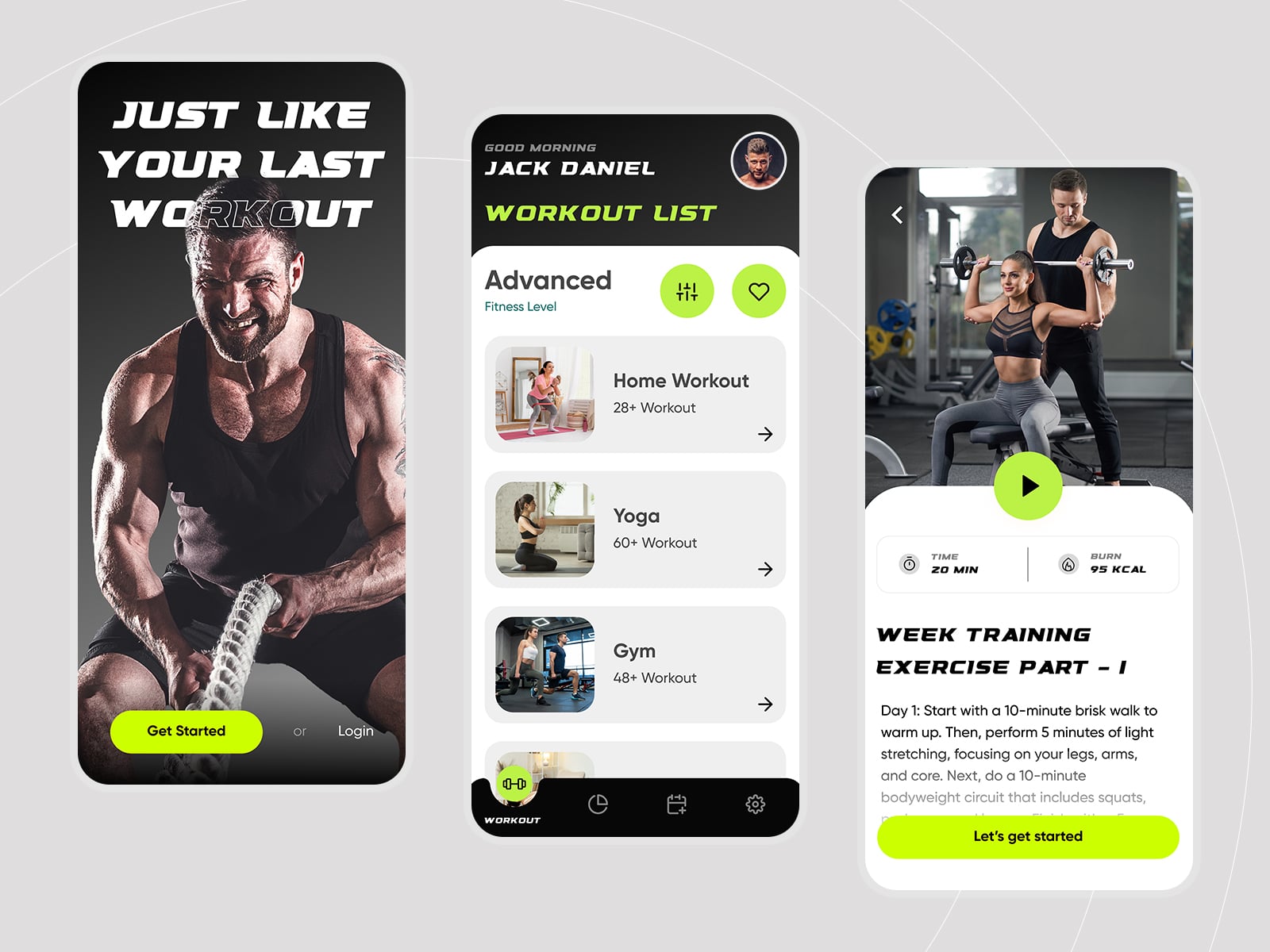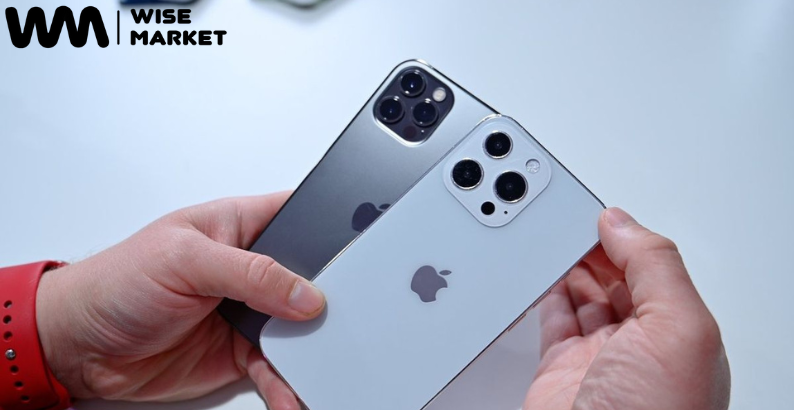A fitness app is an excellent idea for a new startup, particularly for people with expertise in the area. This article will present the complete guide for fitness app development, provide the various types that available fitness applications, as well as provide suggestions on how to create a successful app.
Types of Fitness apps
The various kinds of fitness apps deal with various issues. Fitness apps can assist users with nutrition, training, and monitoring their activity. Let’s take a closer look at each kind of fitness application and the features it offers.
Exercise and workout apps
Workout apps are an ideal solution for those who do not have the time or motivation to join a fitness center or attend class with other people. According to Flurry Analytics fitness programs for weight reduction and workouts comprise 73 % of all fitness and health app sessions.
Alongside offering a list of exercises, certain fitness apps allow users to design or modify their workout plans. Many modern fitness apps connect to fitness trackers like those from Fitbit and Garmin to gather the user’s health and activity-related information and offer individual health tips.
When creating your fitness app, you should focus on user-friendliness. Sorting workouts by the type of workout is always an ideal idea. It helps searchers, making it easier for users to locate the thing they’re looking for.
For example, Nike Training Club offers users a range of workouts that have a different focus on endurance, strength mobility, and strength. The app offers video demonstrations as well as audio-guided exercises. To make it quick and simple for users to locate the training they need, Nike Training Club provides filters that cover duration, intensity, level of equipment, type, and focus. Users can pick their preferred training programs depending on their preferences and modify or alter the plan if required. For Nike, the application assists them in engaging with their customers and increasing brand recognition.
Another app for fitness, Alo Moves, provides yoga videos. To assist users in finding the best course, Alo Moves lets them select the duration and instructor style, difficulty, and intensity. It also comes with community features that let users connect and post comments about classes.
For those who require more than pre-made plans and classes, There are apps for personal trainers. Personal trainer apps bring fitness instructors and people who prefer a more personal approach. They provide the personal trainer on a smartphone.
Let’s use Fitmo as an illustration. The Fitmo application allows users to choose coaches. However, first users must select goals. Then, they select the coach that best matches their goals. Coaches design customized programs to the objectives of a specific user and also provide feedback. Fitmo allows video and text calls to let users as well as coaches communicate. It also integrates with fitness trackers, letting users keep track of their progress and share their findings with coaches.
Fitness Tracking Apps
Fitness tracking applications aim to collect information on the user’s activity. This can include the number of steps taken, the stairs that were climbed, distances run as well as other fitness metrics. To help users keep track of the progress of their fitness, apps for tracking offer charts and calendars, and save routes.
For features sync with wearable devices is essential for fitness tracking apps.
Another important feature is geolocation to track and save routes to a map. It’s not just useful to keep track of progress but also encourages users since they can track the routes they’ve taken or cycled.
Let’s examine the capabilities of Runkeeper the fitness-tracking app that has over fifty million people. Despite the name, this fitness application, Runkeeper tracks various activities like swimming, cycling, walking, and snowboarding. It lets users set goals that they are aiming to meet like getting ready for a marathon and also provides training programs. To keep users on track, Runkeeper allows them to take part in challenges and earn rewards. Additionally, the app has an audio cue feature that allows users to know the duration and time they’ve walked or run to keep them focused. With Runkeeper users can enjoy music during running due to iTunes along with Spotify integration.
Nutrition and Diet Apps
A Statista survey reveals that 26 percent of 18-to- 29-year-olds are using apps to track the nutrition of their children regularly, while 23 percent of people in the same age group are using them only occasionally. Diet and nutrition apps can allow users to track the calories they consume and regulate their water balance.
With apps for nutrition, users can establish goals they would like to achieve, like losing or increasing weight. To help users track their food habits such apps should include a logging of food feature.
Motivational users are crucial in any fitness application. Apps for nutrition should assist users to remain motivated as well. This could be accomplished by letting users know what they can do to achieve their goals, displaying the progress they have made, sending push notifications, and utilizing gaming elements such as competitions.
Several well-known application for counting calories is MyFitnessPal. It offers suggestions on how many calories to take in, based on the fitness goals of the user as well as their profile. MyFitnessPal determines the amount of calories burned and consumed about the meals and exercise data that users record. To help speed up food logs it has barcode scanners to help to record food items and their nutritional values by scanning a barcode and taking the data.
The most important features of a nutrition app are:
- Calorie counting: The apps for nutrition count calories burned and consumed. They also calculate daily calorie targets.
- Food logging: Users would like to be able to record their food intake in the quickest time possible. MyFitnessPal comes with an integrated barcode scanner so that users don’t have to enter food items manually. It lets users also make recipes by making use of ingredients by hand or adding them automatically via the internet.
- Integration with Wearable Devices: Through fitness trackers, information about users’ activities can be automatically added.
- Database of nutritional information: Making a database requires a lot of time. There’s an alternative which is to make use of an API for the database you already have. For instance, MyFitnessPal has its database and offers its MyFitnessPal API to connect to it.
- Recommendations: To make your nutrition apps more personalized it is possible to give users useful health advice about their diet as well as their goals, activities, and.
Monetization strategies
After having reviewed various types of fitness apps, let’s have some time to look at strategies for monetizing. Similar to other apps fitness apps, fitness apps can be made monetizable. There are many possibilities for monetization that you can think about.
- Paid application: The choice of this method to monetize your fitness app could be beneficial when you already have a loyal customer base or following base. However, if you’re only beginning to establish your brand, you may need to think about another strategy.
- Freemium: By using this feature, you offer both paid and free features. In the case of fitness apps paying features can include advanced workout plans, or specific services such as feedback.
- Ads: Be cautious with this type of advertisement since annoying advertisements can turn users away. Products featured within your app must be health-related and fitness-focused. For instance, yoga app users can find yoga mat ads useful.
- Sponsored Content: If you develop content for your app, you could include content from other professionals or companies. However, you must remember to consider the customers. Content sponsored by sponsors must be informative and useful.
Tips for Fitness App Development
The fitness app market in the world is growing rapidly and is predicted to grow even more. There’s a huge demand for different kinds of fitness apps, however, there’s intense competition. Here are some suggestions and suggestions for fitness app development.
Encourage users to continue their training
According to 38Plank founder Andrew Cole, it’s crucial to provide users with an incentive to use an app for fitness. 38Plank is one example. It has created the fitness challenge for charity Abs to help people with Epilepsy. By exercising more, users make more money to support the cause. This is a fantastic idea as being part of a group and doing something worthwhile encourages people to continue.
Another option is to use motivational material such as pictures, quotes, or stories of success, which can help users reach their goals.
Be sure to show your expertise
Informational content that teaches users can help establish confidence. It is possible to share your knowledge and provide helpful health-related advice as well as news. It will prove that you are an expert in your area of expertise. Consider what your ideal public is looking for and ask them about any concerns they might be having.
MyFitnessPal For instance, MyFitnessPal offers an in-app blog that includes videos and articles, which provide recipes and fitness tips.
Make it enjoyable to utilize your application
If you can make your fitness app fun the users won’t need to be forced to workout. Gaming and elements such as leaderboards and quests can aid you in achieving this. Zombies, Run! is more of a running-themed game than a fitness application however, it illustrates how you can transform running into something enjoyable and engaging. Zombies, Run! puts the user in a post-apocalyptic environment where they need to race towards zombies. It requires users to wear headphones and accelerate whenever they hear the sound of zombies coming.
Gamification can help to motivate and keep users. It also provides users with incentives to exercise when they can win a prize or earn rewards. In the end, who wouldn’t want to be the first?
Remember to include beginner
Keep in mind that many of those who are looking into fitness apps are total novices. They require guidance and advice regarding how to exercise correctly. Yet, some fitness apps don’t have videos showing the proper way to exercise. Although it’s not essential for advanced users, it’s essential for those who are just starting.
SWEAT, a health and fitness app developed by Kayla Itsines, gives an instructional video for each exercise to ensure that the users are aware of the correct method of exercising.
Form a community that lets users help one another
As you might have noticed, a few applications we’ve discussed include community features, such as commenting on friends’ posts and adding them to your list. Help from fellow users can help motivate. Additionally, they may have similar goals, and community tools allow them to share their experiences. The ability to post their accomplishments on social media might not suffice.
The social component is one of the major benefits of Strava, which is a tracker app. As a fitness and social networking platform, the app allows users to connect with individuals with similar desires, be motivated, and share their progress and accomplishments. Strava creates a community of like-minded individuals who help and encourage one another.
Create a custom strategy to better satisfy the needs of users
Technology is evolving rapidly in the present and you can make use of the latest technology to enhance your fitness app to be more customized.
Freeletics offers a customized fitness coach powered by artificial Intelligence like. By using machine learning and artificial intelligence Freeletics’ Freeletics digital coach can tailor training plans to meet the needs of a person. While athletes exercise, the coach will evaluate their performance. This way it can learn and become more sophisticated. By observing changes in performance, Freeletics adapts workout plans to assist users in achieving more efficient results and avoiding excessive training.







